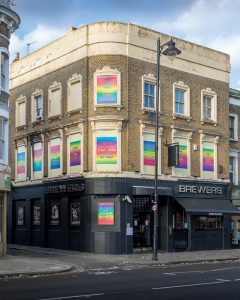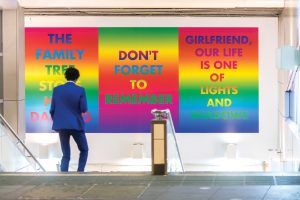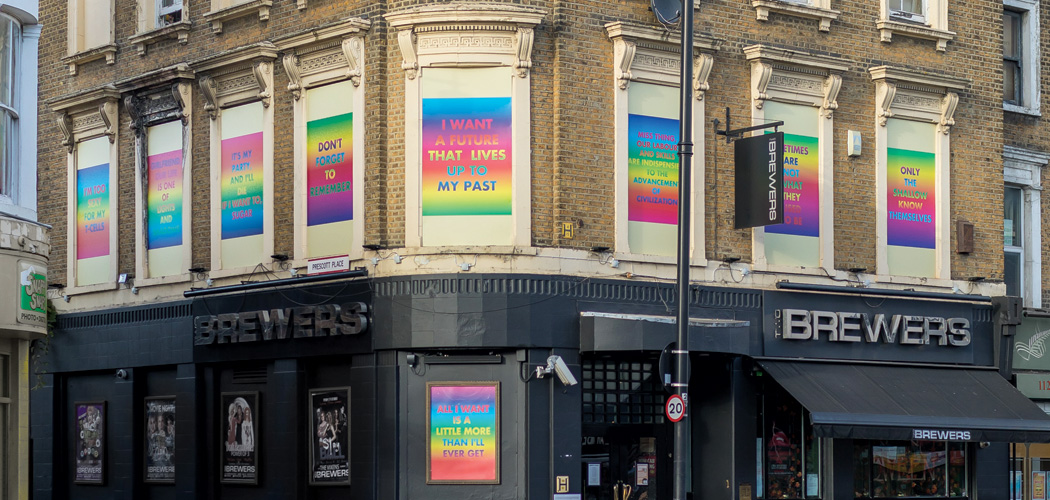This month Studio Voltaire launches its first ever ‘art in the public realm’ project with David McDiarmid’s Rainbow Aphorisms – a series of large-scale public works installed across sites in Clapham and Brixton, in collaboration with Art on the Underground and This Is Clapham. Joe Scotland, Director, Studio Voltaire, explains more.
What is the exhibition Rainbow Aphorisms about?
Rainbow Aphorisms are a series of printed works that the late Australian artist David McDiarmid made from 1993 until his death of AIDS-related conditions in 1995. The prints show bold and poignant san-serif texts superimposed on a background of full spectrum rainbow colours. The works were created in response to his communities’ response to the AIDS crisis. Some of the works reference the toxic response by the media as well as retaliations to homophobic comments, all delivered with pithy humour.

Working closely with the artist’s estate, we have reproduced the series as public artworks across Clapham and Brixton working with Art on the Underground and This Is Clapham. They can be seen across the facade of our neighbourhood LGBTQ+ cabaret bar the Two Brewers in Clapham, on the roof of our gallery, at Brixton Underground station and as posters across the London Underground network. Over the year they will also appear at other locations across London.
What can you tell us about David McDiarmid?
David McDiarmid was an artist, designer and activist, recognised for his prominent and sustained artistic engagement in issues relating to queer identity and history. He was born in 1950s Tasmania and became a very important figure in the emergence of LGBTQ+ culture in Australia and has made significant contributions to the culture of HIV/AIDS internationally. David is also known for his involvement in the gay liberation movement of the early 1970s, being the first homosexual man to be arrested for gay rights protesting in Australia, and as the creative director of the Sydney Gay and Lesbian Mardi Gras. However, his work is little-known in the UK.
Where did the idea come from to stage this exhibition?
I visited Australia in 2016 on a research trip with the Australian Arts Council and was introduced to David’s work, which made an immediate impact on me. I was very keen to bring his work to London. It feels very timely and urgent to be presenting this kind of work to both our LGBTQ+ communities in London and a much wider general public.

Was the idea to display the work outside especially for David’s work or was he the perfect fit for the idea?
It was a mixture of both. David wanted his work to be seen by as many people as possible and not just by the art world. In 1995, one of the works from the Rainbow Aphorism series was displayed on the façade of the National Gallery of New South Wales in Sydney, but since then they have only really been seen inside galleries and museums. We wanted to bring them into the public realm again.
This year we initiated a new programme of projects with This Is Clapham that take place along Clapham’s High Street. We knew that this opportunity would be perfect for David’s work because of Clapham’s established LGBTQ+ history and community. Our gallery is a stone’s throw away from Two Brewers and it felt nice to link the two cultural spaces.
David’s commitment and involvement in the community arts movement and the Sydney Gay and Lesbian Mardi Gras also made the work seem particularly relevant to being displayed outside and this will inspire the work we do within the local area take place over the next year, working with local LGBTQ+ groups, healthcare partners and schools.
What is it about his work that appeals to you and Studio Voltaire?
Studio Voltaire often engages with ideas and subjects that often get overlooked or ignored such as gender, identity, sexuality and health. David’s work appeals on so many levels. These works in particular lay bare the historical truths about society’s response to the AIDS crisis, in such a way that it is still relevant today, particularly when society continues to relegate vulnerable and marginalised voices.
Can you tell us about Art on the Underground and their input?
Art on the Underground has been an integral partner and co-commissioner of the project. They have amplified David’s work by displaying the series across the London Underground network and at Brixton Underground Station entrance. These works will be seen by millions of people because of Art on the Underground’s involvement and support.
And what about the Two Brewers?
Historic Two Brewers was the obvious site to display the work in Clapham and we really wanted to make a link between the gallery and the bar. Their team has been incredibly supportive and generous, immediately realising the power and relevance of David’s work. The Two Brewers are a vital LGBT+ cultural and social space, greatly enriching the local area.
For more visit studiovoltaire-org














